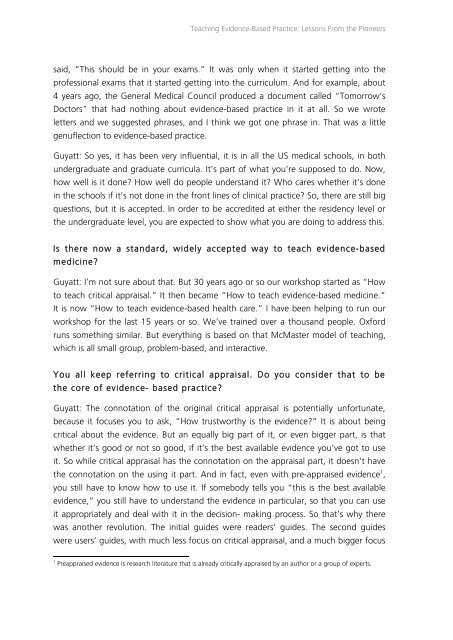In Search of Evidence
jqluvth
jqluvth
You also want an ePaper? Increase the reach of your titles
YUMPU automatically turns print PDFs into web optimized ePapers that Google loves.
Teaching <strong>Evidence</strong>-Based Practice: Lessons From the Pioneers<br />
said, “This should be in your exams.” It was only when it started getting into the<br />
pr<strong>of</strong>essional exams that it started getting into the curriculum. And for example, about<br />
4 years ago, the General Medical Council produced a document called “Tomorrow’s<br />
Doctors” that had nothing about evidence-based practice in it at all. So we wrote<br />
letters and we suggested phrases, and I think we got one phrase in. That was a little<br />
genuflection to evidence-based practice.<br />
Guyatt: So yes, it has been very influential, it is in all the US medical schools, in both<br />
undergraduate and graduate curricula. It’s part <strong>of</strong> what you’re supposed to do. Now,<br />
how well is it done? How well do people understand it? Who cares whether it’s done<br />
in the schools if it’s not done in the front lines <strong>of</strong> clinical practice? So, there are still big<br />
questions, but it is accepted. <strong>In</strong> order to be accredited at either the residency level or<br />
the undergraduate level, you are expected to show what you are doing to address this.<br />
Is there now a standard, widely accepted way to teach evidence-based<br />
medicine?<br />
Guyatt: I’m not sure about that. But 30 years ago or so our workshop started as “How<br />
to teach critical appraisal.” It then became “How to teach evidence-based medicine.”<br />
It is now “How to teach evidence-based health care.” I have been helping to run our<br />
workshop for the last 15 years or so. We’ve trained over a thousand people. Oxford<br />
runs something similar. But everything is based on that McMaster model <strong>of</strong> teaching,<br />
which is all small group, problem-based, and interactive.<br />
You all keep referring to critical appraisal. Do you consider that to be<br />
the core <strong>of</strong> evidence- based practice?<br />
Guyatt: The connotation <strong>of</strong> the original critical appraisal is potentially unfortunate,<br />
because it focuses you to ask, “How trustworthy is the evidence?” It is about being<br />
critical about the evidence. But an equally big part <strong>of</strong> it, or even bigger part, is that<br />
whether it’s good or not so good, if it’s the best available evidence you’ve got to use<br />
it. So while critical appraisal has the connotation on the appraisal part, it doesn’t have<br />
the connotation on the using it part. And in fact, even with pre-appraised evidence 1 ,<br />
you still have to know how to use it. If somebody tells you “this is the best available<br />
evidence,” you still have to understand the evidence in particular, so that you can use<br />
it appropriately and deal with it in the decision- making process. So that’s why there<br />
was another revolution. The initial guides were readers’ guides. The second guides<br />
were users’ guides, with much less focus on critical appraisal, and a much bigger focus<br />
1<br />
Preappraised evidence is research literature that is already critically appraised by an author or a group <strong>of</strong> experts.


